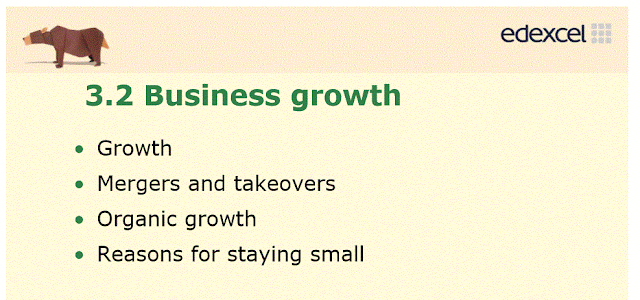Starbucks stores:
Why do businesses like to grow?
1. Higher revenue / profitability.
2. The business will have an increased market share and brand recognition.
3. Economies of Scale:
Unit costs are likely to be lower as a business grows.
Internal economies of scale are the benefits of growth that arise within the firm.
Purchasing and marketing economies:
Large firms can get better rates when buying raw materials or components.
How much will Starbucks pay for each cup they use?
Purchasing Economies: where does your local convenience store buy stock?
Marketing economies:
These arise from spreading the fixed cost of promotion over a larger level of output.
Technical economies:
As the scale of operations rises so the business can operate more efficiently.
Larger factories.
Flow production.
More efficient machines.
Robotics.
Specialisation and managerial economies:
As the firm grows it can afford to employ specialist managers.
Larger firms find it easier to raise finance at competitive rates.
They may have large assets they can use for security.
They may be able to issue new shares.
Risk bearing economies:
Larger firms may diversify into different operations.
Larger firms may benefit from spending on R&D.
External economies of scale:
The reductions in cost as an industry grows.
Labour economies:
A skilled workforce may develop where an industry is concentrated:
Silicon Valley in California -
Training costs may be reduced if staff are hired from similar businesses.
Local education providers may offer specialist courses.
Ancilliary and commercial services economies:
Specialist banking, insurance, marketing and distribution services may be available
Co-operation economies:
Firms may agree to share the cost of R&D.
4. Increased market power over customers and suppliers.
How might the proposed merger between Sainsburys and Asda have increased market power?
Choosing the optimal mix of resources:
Capital versus labour intensive industries.
As businesses get bigger they get more dominant.
Customers may suffer if a dominant business is able to charge higher prices and competition is limited.
Also customers may suffer as there is little need for innovation in this market.
Suppliers may suffer if they are reliant on certain customers for very large orders.
Why are these farmers angry?
Click on the picture:
Increased market share and brand recognition.
As the brand becomes stronger, a business may be able to:
Click on the picture:
Charge higher prices.
Differentiate the product from those of rivals.
Create customer loyalty.
Enhance product recognition.
Launch new products more easily. See here.
Increased profitability:
Larger businesses tend to make higher profits than smaller ones.
1. Diseconomies of Scale:
Average cost per unit rises as output increases.
Internal diseconomies of scale.
Communication problems
As the business expands communicating between different departments and along the chain of command becomes more difficult.
Distorted messages.
A lack of clear instructions.
Wider spans of control.
More reliance on written communication rather than face to face feedback.
Click on the pictureParts of the organisation not working together to achieve corporate objectives.
Nice link here.
External diseconomies of scale.
These may occur from overcrowding in particular geographical areas.
The price of property, labour and services can rise.
Nice link here.
Evidence of diseconomies of scale at Tesco?
2. Overtrading:
Overtrading occurs when a business tries to fund a large volume of new business without sufficient resources.
As a result it runs out of cash.
Possible reasons:
A business starts with insufficient capital.
A business offers too much trade credit to customers.
A business has very slim profit margins.
How to reduce the risk of overtrading?
Ensure appropriate payment terms are agreed with customers and suppliers.
Debt factoring, to reduce the risk of bad debt.
Offer discounts for prompt payment.
Complete a cash flow forecast to help plan for periods of negative cash flow.
Arrange external sources of finance to support a negative cash flow balance like an overdraft or loan.
The link between Tie Rack and Zone 1:












